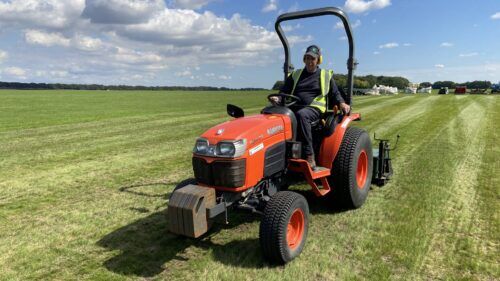Home ▸ Lawn Care Guide ▸ Mowing your lawn ▸ Step by step guide on mowing
Step by step guide on mowing
Mowing your lawn
- Ensure you complete any mower maintenance before the start of the season e.g. getting blade sharpened, pre-season service, filing up with fresh fuel if you have a petrol mower
- Clear the lawn of any debris like sticks, stones or toys to avoid damaging your mower and avoid the risk of being hit by any debris that is ejected
- Adjust the mowing height as appropriate for the conditions and time of year. When doing the first mow of the year following Winter, it can be tempting to take a load off, but we recommend never removing more than 1/3 of the grass mowing height at a time. In times of drought it’s also worth leaving the lawn a little longer, as this helps the grass retain moisture better and provide a degree of shade from the sun
- Avoid mowing in very wet and soft conditions to avoid wet grass clumping and clogging the mower, as well as risk scalping the lawn
- For irregular lawns, mowing can be made easier by cutting around perimeters and obstacles first to create a squared off mowing area
- Once you have done your perimeters you should be left with a more regular square or rectangle area and be able to mow in rows. Start at one edge of this and mow in a straight line. When you get to the end, turn the mower and come back down to mow your second row. Try and overlap the lines by a small amount to make sure nothing is missed
- Don’t always mow your rows in the same direction. Change up between mowing north-south rows and east-west rows to avoid grass bending permanently in one direction and minimising track marks

FAQ
How often should I mow?
This does vary depending on the time of year, but generally we would say mow a minimum of once a week. During the growing season, however, you may want to ramp that up to twice a week! The best way to think about this is if your lawn looks like it needs mowing then you have left it too late!
If you are not mowing regularly enough, then you’ll end up having to mow the grass at a longer length which can clog up lawn mowers and also can stress the grass plant, if more than 1/3 of its height is removed in one go.
What height should my mower’s blades be?
We get this one a lot, and we recommend that you try to cut between 20mm and 40mm for a regular domestic lawn. The reasons behind this are to help push out the weeds, encourage a healthier root system, reduce the likelihood of disease damage and to minimize stress on the lawn during drought periods. Mowing too short means you are more likely to scalp the lawn and leave patches, which weed seeds may take advantage of and fill in! In times of hot, dry weather, leaving the grass a little longer than usual will help to keep it protected and reduce the risk of it drying out.
Should I collect my grass clippings?
Here’s a subject which divides opinion: whether to collect the clippings in the mower’s box or to leave the box off and allow the clippings to mulch down on the lawn. Those clippings contain mostly water and nutrients, so could be a valuable source of both to your lawn. However, leaving organic matter decomposing on the lawn can also encourage lawn diseases and thatch build-up. If you have a mower with a mulching attachment that cuts the clippings into many fine pieces, this should be fine providing the lawn is mowed at least twice per week, but we generally advise collecting the clippings as our UK lawns generally receive enough moisture.
How can I avoid scalping?
Avoid mowing when the ground is too soft, as the wheels are likely to sink in and cause scalping. Don’t cut the lawn too close and take turns slowly with the mower. If you have an uneven or bumpy lawn it may be difficult to avoid scalping and so repairs should be considered to level out the lawn. For minor lumps and bumps, this can sometimes be addressed by aerating, over seeding and brushing over topdressing.
